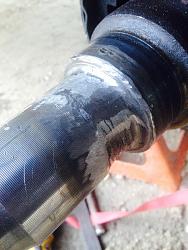Frank:
Now the quality assurance side of me is kicking in. If your idea is to do a weld repair and insitu machining - this can only be a stop gap measure until you get it back to the shop. Any welding in a highly stressed area needs to be heated up to a pretty high temperature before, during and after welding. Then you need to stress relieve that welded area, or it will just crack again and again. You might also consider MIG welding a 60 series wire in the root and then stick weld the filler and cap using 7018 rods. This way you can control the warping a bit better. After your all done, use magnetic particle inspection to check for surface cracks you might have induced during your welding and or grinding process.
Hope this helps.
Nixrox


 LinkBack URL
LinkBack URL About LinkBacks
About LinkBacks


 Reply With Quote
Reply With Quote




Bookmarks